Transoesophageal echocardiography during interventional cardiac catheterisation in congenital heart disease
- PMID: 11709531
- PMCID: PMC1766548
- DOI: 10.1136/heart.86.suppl_2.ii23
Transoesophageal echocardiography during interventional cardiac catheterisation in congenital heart disease
Figures

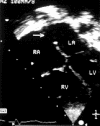

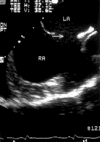

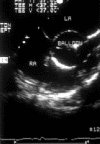
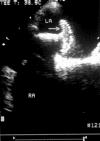
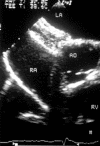
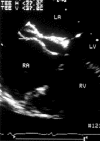







Similar articles
-
Supravalvar mitral ring with complete atrioventricular septal defect: a case report and three-dimensional echocardiography evaluation.J Am Soc Echocardiogr. 2010 Jul;23(7):792.e1-2. doi: 10.1016/j.echo.2009.11.027. Epub 2010 Feb 1. J Am Soc Echocardiogr. 2010. PMID: 20117914
-
Transcatheter treatment of Lutembacher syndrome: combined balloon mitral valvuloplasty and percutaneous atrial septal defect closure.J Invasive Cardiol. 2004 Nov;16(11):678-9. J Invasive Cardiol. 2004. PMID: 15550747 No abstract available.
-
Transoesophageal echocardiography in adult congenital heart disease.Heart. 2001 Dec;86 Suppl 2(Suppl 2):II30-II40. doi: 10.1136/heart.86.suppl_2.ii30. Heart. 2001. PMID: 11709532 Free PMC article. Review. No abstract available.
-
[Transesophageal and intracardiac echocardiography in therapeutic cardiac catheterizations of structural heart disease].Masui. 2014 Sep;63(9):982-7. Masui. 2014. PMID: 25255660 Japanese.
-
[Catheter interventions in congenital heart defects as alternatives to open surgery].Lakartidningen. 2005 Jul 11-24;102(28-29):2060-3. Lakartidningen. 2005. PMID: 16097174 Review. Swedish. No abstract available.
Cited by
-
The causes of Charcot-Marie-Tooth disease.Cell Mol Life Sci. 2003 Dec;60(12):2547-60. doi: 10.1007/s00018-003-3133-5. Cell Mol Life Sci. 2003. PMID: 14685682 Free PMC article. Review.
-
What is new in pediatric cardiology.Indian J Pediatr. 2003 Jan;70(1):41-9. doi: 10.1007/BF02722744. Indian J Pediatr. 2003. PMID: 12619952 Review.
-
[Catheter interventions for congenital heart disease].Herz. 2008 Dec;33(8):592-600. doi: 10.1007/s00059-008-3133-1. Epub 2009 Jan 8. Herz. 2008. PMID: 19137250 Review. German.
-
Position Statement on Indications for Echocardiography in Fetal and Pediatric Cardiology and Congenital Heart Disease of the Adult - 2020.Arq Bras Cardiol. 2020 Nov;115(5):987-1005. doi: 10.36660/abc.20201122. Arq Bras Cardiol. 2020. PMID: 33295472 Free PMC article. English, Portuguese. No abstract available.
-
Imaging of patients with congenital heart disease.Nat Rev Cardiol. 2011 Nov 1;9(2):101-15. doi: 10.1038/nrcardio.2011.162. Nat Rev Cardiol. 2011. PMID: 22045045 Review.
References
Publication types
MeSH terms
LinkOut - more resources
Full Text Sources
Medical
